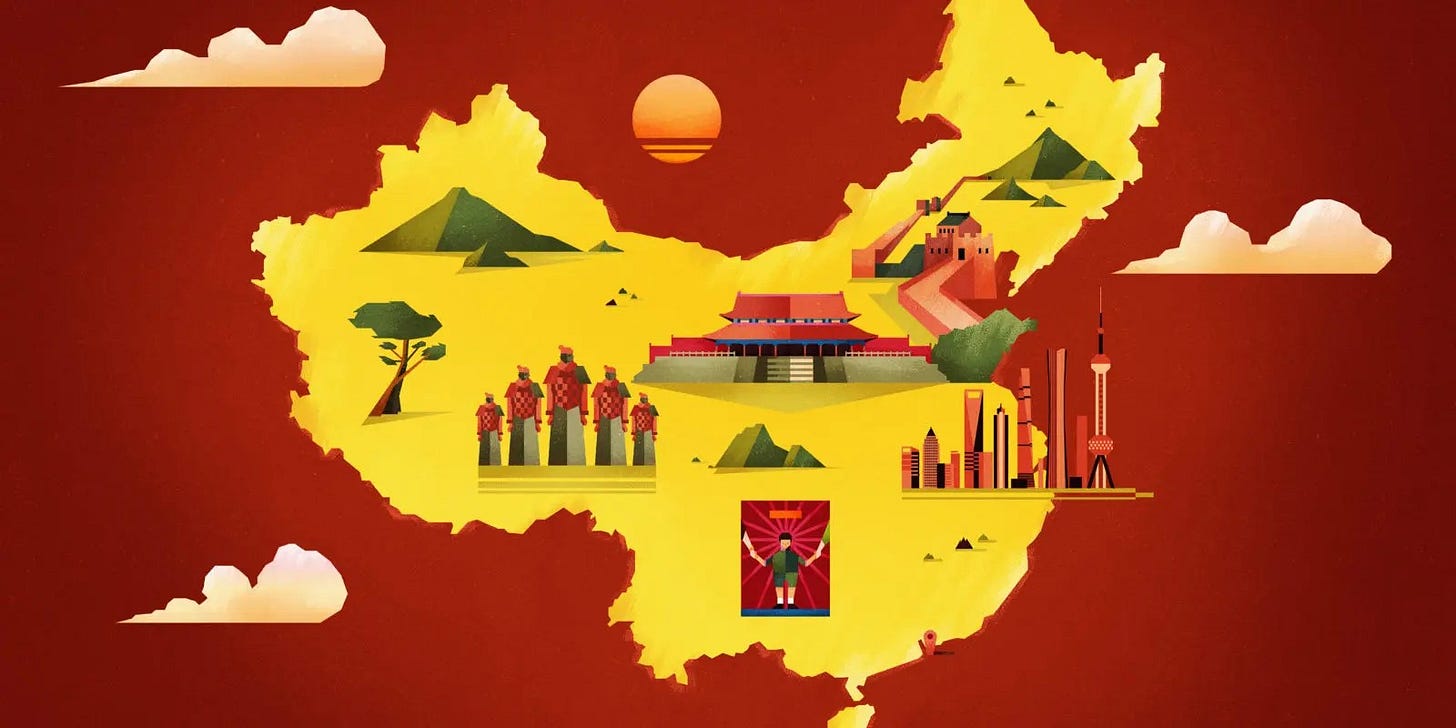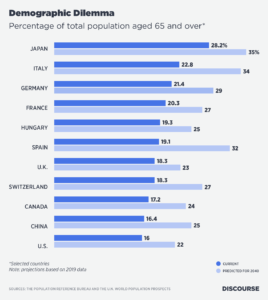The China Challenge: A Demographic Predicament Will Plague the Mainland for Decades
Faced with a rapidly aging population, a shrinking workforce and a falling fertility rate, there’s little the country can do
By Nicholas Eberstadt
Of all the major uncertainties about China’s future, the country’s demographic outlook is the least uncertain. Most of the people who will be living in China in, say, 2040 are already alive there today. Population projections are far from error-free, but if we are trying to peer ahead a couple of decades, they are more reliable than estimates for economic change, much less political or technological change. And what the population projections show is that the situation for China is dire.
Beijing relaxed its coercive one-child policy in 2016, allowing all couples to have two children, and then announced last month that it will allow all couples to have three children. But this is unlikely to boost the country’s long-term population growth, and projections made before the policy shift show that the current population, 1.4 billion, will be roughly the same in 20 years. We already know that in 2040 the over-65 contingent will be vastly larger while the key cohort of younger workers (today’s children) will be dramatically smaller. Given this demographic challenge and other factors, the next 20 years won’t see a repeat of the phenomenal economic success that China enjoyed over the past 40 years. China’s era of heroic economic growth will end, quite possibly sooner rather than later.
In the early 1990s, China’s fertility rate dropped below the replacement level of 2.1 babies born to each woman on average over her lifetime. Last year it fell to 1.3, according to Chinese census data released last month, and by 2040 it will have been below replacement for almost half a century. (The U.S. rate was 1.64 last year.) Small families make gray societies. Two generations of very low fertility will raise China’s median age to at least 48, which is where famously aging but far richer Japan is today.
China is a low-migration, low-mortality, low-fertility society, so there is little turnover in the population from one year to the next. But there will be a huge turnover in the population’s composition in the next two decades. Due to the steep decline in childbearing, the population is on track to peak in a decade or less—the U.S. Census Bureau says 2027—and then shrink at an accelerating tempo. While China is thought to be growing by 4 million a year now, it will be shrinking by 4 million a year in 2040, according to the bureau. Incidentally, India edges out China as the world’s most populous country around 2026.
By 2040 China’s working-age population (ages 15-64) will have been falling for more than a quarter century, and at an ever-greater speed. Between December 1978, when Deng Xiaoping pointed China in a new economic direction and changed the course of history, and 2010, this population grew by 80%, to almost a billion. This meant that labor availability rose by 1.8% a year, and total work hours may have risen even more rapidly as the economy absorbed underemployed labor. But growth in the workforce peaked around 2014, and China’s diminishing working-age population is projected to plummet by more than 130 million by 2040, to around 860 million. At that point it will be dropping at a rate approaching 1% a year.
Looking at this more closely, we see that the pool of young workers—the healthiest and best educated contingent in the labor force—is on track to decline even more sharply. Only the pool of older workers, 55-64—the least healthy and least educated part of the workforce—will be expanding. This is not the way economic planners design things.
At the same time, China’s elderly population will explode. By 2040, barring catastrophic die-offs of its seniors, China will be a “super-aged society,” with 22% of its people 65 or older (20% is the conventional threshold for super-aged). The over-65 cohort will be almost twice as large as in 2020, and the 80-plus group is expected to be nearly two-and-a-half-times larger.
How China copes with its coming senior tsunami is critical to its future. There are no easy answers. Older Chinese are highly dependent on outside resources for their sustenance—earning less than half as much as they consume by 65, and less than a fifth as much after 70, according to the National Transfer Accounts network. But public pension and healthcare guarantees for most of China’s population remain rudimentary and meager, and the family, China’s traditional safety net, is withering rapidly.
The one-child policy, mandated in 1980, resulted in boys vastly outnumbering girls at birth. China has been reporting abnormally high sex ratios since 1982. Historically, sex ratios worldwide range from 103 to 105 boys for every 100 girls at birth. The U.S. Census Bureau says China’s sex ratio at birth peaked at 118 in 2005, fell to 113 by 2018 and will be 107 in 2040. This has long created another demographic dilemma for China: a major shortage of brides and a “marriage squeeze” for men. In bureau projections for China 2040, there will be 30 million more men ages 30 to 50 than women 25 to 45, or 17% of the total number of males in that age group.
What will it mean for China to have a growing number of unmarriageable, predominantly poor and poorly skilled young men? Does the “bare branches” problem—the Chinese term for men lacking wives and thus not adding descendants to the family tree—portend social or political instability? Or just many more male lives of quiet desperation as family lineages die out? There is no obvious solution for the marriage squeeze. At the very least, it’s a wild card—possibly an important one—in predicting China’s future.
China is also confronting other important demographic difficulties: migration and urbanization, and the changes in family structure.
The migration of labor from agriculture to industry and from country to city helped fuel China’s extraordinary economic boom, but that pattern is reaching its limit. Under China’s hukou household registration system that figures so prominently among the regime’s tools of social control, almost all migrants to cities retain their “peasant” hukou. This means they are, in effect, illegal aliens in their own country, second-class citizens subject to discrimination and exploitation by urban locals. Nevertheless, vast numbers of migrants have been moving to urban areas since the 1980s, and they now comprise most of the young workers in China’s biggest cities.
But the flow of migrants has been dwindling and may be going into reverse. Since fertility rates for the “in-hukou” natives of China’s big cities have been extremely low for over a generation, the local population and workforce are shrinking, so China’s economic engine needs more and more fresh workers from the countryside to keep chugging ahead. Urban China, however, has already cherry-picked most of the best workers from the countryside in previous waves of migration, and now President Xi Jinping is encouraging people to stay in or move back to their rural towns to reduce inequality.
Meanwhile, China is experiencing an extraordinary revolution in family structure as the slumping fertility rate and the rise of the only child over the past four decades has meant much smaller extended families. Only children begetting only children has led to a new type of family in China: girls and boys with no siblings, cousins, uncles or aunts, only ancestors and (maybe) descendants.
This is sharply compressing kinship networks, which hold a particularly prominent institutional and even spiritual role in Chinese tradition. For millennia, guanxi networks—comprised principally but not exclusively of fellow clansmen—have helped provide financial and personal security for Chinese. What will happen to China’s economic performance as these networks increasingly contract? We are about to find out. The implications of the radical changes in China’s family structure are difficult to assess, but they could have truly profound ramifications.
China is certainly capable of generating creditable rates of economic growth for the foreseeable future. Its economy will grow by an average of 3% a year over the next 20 years, according to an estimate from Stanford University’s Scott Rozelle and his colleagues that uses a human capital-based model emphasizing the relationship between education and productivity. My own estimate based on four factors—health, education, urbanization and business climate—is roughly 2.5% a year for 2025 through 2040 in purchasing-power-parity terms and a somewhat higher rate in exchange-rate terms. By taking into account demographic factors, these projections are lower than most estimates.
Demographic constraints could also complicate Beijing’s quest to apply its political power abroad. The regime is behaving in an ever more ambitious and assertive fashion. The era of “hide your strength, bide your time” looks to be over. Indeed, one school of thought says Beijing is behaving this way precisely because it realizes that the weaknesses of its centrally planned system will eventually catch up with it and so it must flex its muscles and lock in its foreign influence now.
Demographic stresses also could reduce social cohesion and contribute to social or political instability. Note the verb “could”: This is, of course, by no means a certainty, but dynasties in China always end.
This is the third article in a series on “The China Challenge.” The first article argues that authoritarian rule, interference in key industries and the legacy of the one-child policy will likely prevent China from overtaking the U.S. The second article takes the opposite position, arguing that freer trade and faster communication encouraged more bad behavior from China, and that’s helping it overtake the U.S. The third article explores China’s immense demographic problems. The fourth article is written by a mainlander who's working in Hong Kong and struggling with identity.





